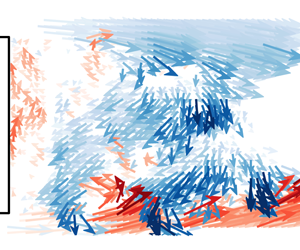Crossref Citations
This article has been cited by the following publications. This list is generated based on data provided by
Crossref.
Haffner, Yann
Borée, Jacques
Spohn, Andreas
and
Castelain, Thomas
2020.
Unsteady Coanda effect and drag reduction for a turbulent wake.
Journal of Fluid Mechanics,
Vol. 899,
Issue. ,
Fan, Yajun
Xia, Chao
Chu, Shijun
Yang, Zhigang
and
Cadot, Olivier
2020.
Experimental and numerical analysis of the bi-stable turbulent wake of a rectangular flat-backed bluff body.
Physics of Fluids,
Vol. 32,
Issue. 10,
Passaggia, Pierre-Yves
Mazellier, Nicolas
and
Kourta, Azeddine
2021.
Aerodynamic drag modification induced by free-stream turbulence effects on a simplified road vehicle.
Physics of Fluids,
Vol. 33,
Issue. 10,
Yu, Zhou
and
Bingfu, Zhang
2021.
Recent Advances in Wake Dynamics and Active Drag Reduction of Simple Automotive Bodies.
Applied Mechanics Reviews,
Vol. 73,
Issue. 6,
He, Kan
Minelli, Guglielmo
Wang, Jiabin
Dong, Tianyun
Gao, Guangjun
and
Krajnović, Siniša
2021.
Numerical investigation of the wake bi-stability behind a notchback Ahmed body.
Journal of Fluid Mechanics,
Vol. 926,
Issue. ,
He, Kan
Minelli, Guglielmo
Su, Xinchao
Gao, Guangjun
and
Krajnović, Siniša
2021.
Influence of the rounded rear edge on wake bi-stability of a notchback bluff body.
Physics of Fluids,
Vol. 33,
Issue. 11,
Aleyasin, Seyed Sobhan
Tachie, Mark Francis
and
Balachandar, Ram
2021.
Characteristics of flow past elongated bluff bodies with underbody gaps due to varying inflow turbulence.
Physics of Fluids,
Vol. 33,
Issue. 12,
Haffner, Yann
Castelain, Thomas
Borée, Jacques
and
Spohn, Andreas
2021.
Manipulation of three-dimensional asymmetries of a turbulent wake for drag reduction.
Journal of Fluid Mechanics,
Vol. 912,
Issue. ,
Hsu, En-Chi
Pastur, Luc
Cadot, Olivier
and
Parezanović, Vladimir
2021.
A fundamental link between steady asymmetry and separation length in the wake of a 3D square-back body.
Experiments in Fluids,
Vol. 62,
Issue. 5,
Aultman, Matthew
Auza-Gutierrez, Rodrigo
Disotell, Kevin
and
Duan, Lian
2021.
Effects of Wheel Rotation on Long-Period Wake Dynamics of the DrivAer Fastback Model.
Fluids,
Vol. 7,
Issue. 1,
p.
19.
Kang, Nam
Essel, Ebenezer E.
Roussinova, Vesselina
and
Balachandar, Ram
2021.
Effects of approach flow conditions on the unsteady three-dimensional wake structure of a square-back Ahmed body.
Physical Review Fluids,
Vol. 6,
Issue. 3,
He, Kan
Minelli, Guglielmo
Wang, Jiabin
Gao, Guangjun
and
Krajnović, Siniša
2021.
Assessment of LES, IDDES and RANS approaches for prediction of wakes behind notchback road vehicles.
Journal of Wind Engineering and Industrial Aerodynamics,
Vol. 217,
Issue. ,
p.
104737.
Li, Xiao-Bai
Chen, Guang
Liang, Xi-Feng
Liu, Dong-Run
and
Xiong, Xiao-Hui
2021.
Research on spectral estimation parameters for application of spectral proper orthogonal decomposition in train wake flows.
Physics of Fluids,
Vol. 33,
Issue. 12,
Urquhart, Magnus
Varney, Max
Sebben, Simone
and
Passmore, Martin
2021.
Drag reduction mechanisms on a generic square-back vehicle using an optimised yaw-insensitive base cavity.
Experiments in Fluids,
Vol. 62,
Issue. 12,
Podvin, Bérengère
Pellerin, Stéphanie
Fraigneau, Yann
Bonnavion, Guillaume
and
Cadot, Olivier
2021.
Low-order modelling of the wake dynamics of an Ahmed body.
Journal of Fluid Mechanics,
Vol. 927,
Issue. ,
Burton, D.
Wang, S.
Tudball Smith, D.
Scott, H. N.
Crouch, T. N.
and
Thompson, M. C.
2021.
The influence of background turbulence on Ahmed-body wake bistability.
Journal of Fluid Mechanics,
Vol. 926,
Issue. ,
Gayout, Ariane
Bourgoin, Mickaël
and
Plihon, Nicolas
2021.
Rare Event-Triggered Transitions in Aerodynamic Bifurcation.
Physical Review Letters,
Vol. 126,
Issue. 10,
Ahmed, D.
and
Morgans, A. S.
2022.
Nonlinear feedback control of bimodality in the wake of a three-dimensional bluff body.
Physical Review Fluids,
Vol. 7,
Issue. 8,
Lippert, Marc
BASLEY, JEREMY
and
Keirsbulck, Laurent
2022.
On the Reliability of Aerodynamic Balance Time-Series for Closed-Loop Flow Control.
SSRN Electronic Journal ,
Khan, Tauha Irfan
Tajik, Abdul Raouf
and
Parezanovic, Vladimir
2022.
Drag reduction of a generic transport vehicle model using a fluidic oscillator.
International Journal of Thermofluids,
Vol. 15,
Issue. ,
p.
100180.

 ${\sim}8\,\%$ compared to symmetry-breaking states. Finally, recent experimental results for unbalanced wakes and methodologies addressing the control of wake asymmetries for drag reduction are discussed and interpreted based on the present findings. This leads us to provide new insights in control methods for wake asymmetries.
${\sim}8\,\%$ compared to symmetry-breaking states. Finally, recent experimental results for unbalanced wakes and methodologies addressing the control of wake asymmetries for drag reduction are discussed and interpreted based on the present findings. This leads us to provide new insights in control methods for wake asymmetries.